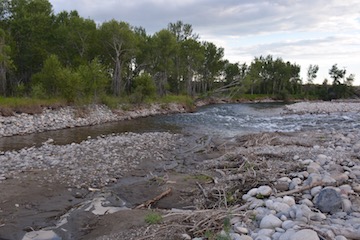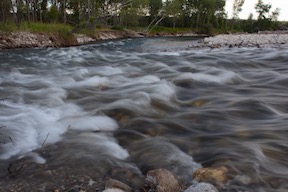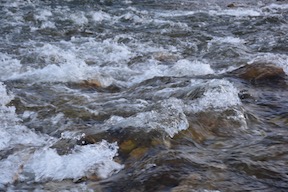Three streams
14/07/15 05:50

It is fun to be back at the place of my childhood summers. You might say that there are three streams that flow nearby each with its own flow and traffic. The property isn’t quite square with the world, so its borders aren’t exactly on the compass directions, but I’m simplifying for the purpose of this blog post. To the south is the highway. The highway that runs along the border of the property is no longer the main road. After I grew up the Interstate Highway was built with its twin bridges about a mile farther upstream. The bridge that is at the corner of the place used to take a lot more truck traffic. We’d hear the jake brakes as the westbound trucks slowed to cross the bridge and enter the town. The eastbound trucks were accelerating, shifting from 7th to 8th or 9th gear as they crossed the bridge, making about 45 mph up the hill and going through the rest of their gears on the flat at the top. I spent some of my childhood hours under that bridge. I could cross the river by walking on the girders that support the highway. I could feel the vibration of the bridge as the trucks crossed. I could lower myself to the island int he middle of the river and explore it without getting wet.
I have a cousin for whom that stream defined a big part of his life. He spent many years and millions of miles driving big rigs on the highway. He can tell the difference between a Volvo 670 and 780 at a glance. He can discuss the merits of Peterbuilt, Kenworth and Freightliner. He can go on and on about his dislike of the Eaton autoshift and Volvo’s similar system that are, in his words, “ruining the profession and making it so that idiots can drive trucks.” It won’t be long, he says, and you can mark his words, before computers will be driving the trucks and there won’t be any jobs left for real people.
A mile downstream from the place to the north is the railroad trestle crossing the river. The engineers blow the whistle before crossing the trestle and each has a distinctive way of making the sounds. We could hear them in the night and also hear the rumble of the trains on the rails as they crossed the river. We were warned to never cross the river on the rails because you can’t outrun a train, but we did so on occasion when there was no train in sight or sound, feeling like we were undertaking a dangerous mission. We climbed on the trestle and floated beneath it on our inner tubes.
I have another cousin who was captured by that stream. He worked for the railroad all of his working career until he retired, mostly installing and repairing electronic switching equipment and later managing sections of track. He can tell you whether the train is carrying grain or coal or consumer goods. He knows the code of the cars in the train and can tell you who owns or leases them, where they are bound, and often what is in the containers. He knows why some wheat and barley from Montana travels by train and other travels by rail. He can explain how the coal traffic used to go east, but now heads west since the disaster with the tsunami and the nuclear plants in Japan. He knows about unit trains and the locations of the large loading and unloading facilities.

